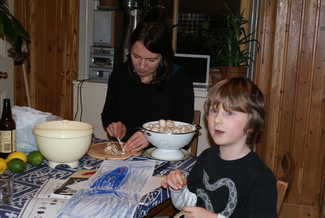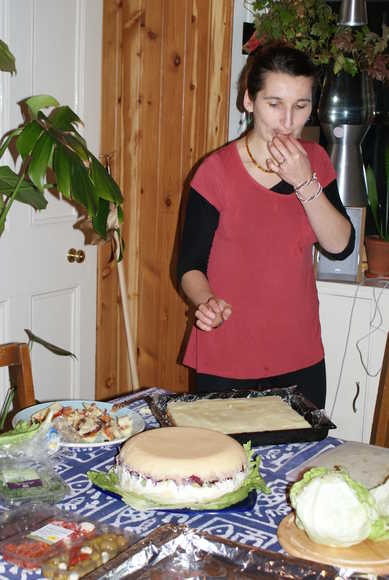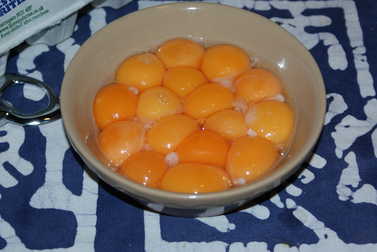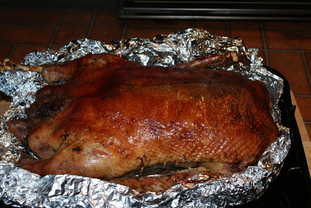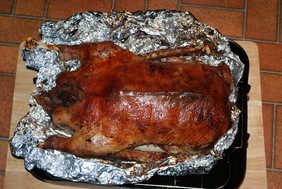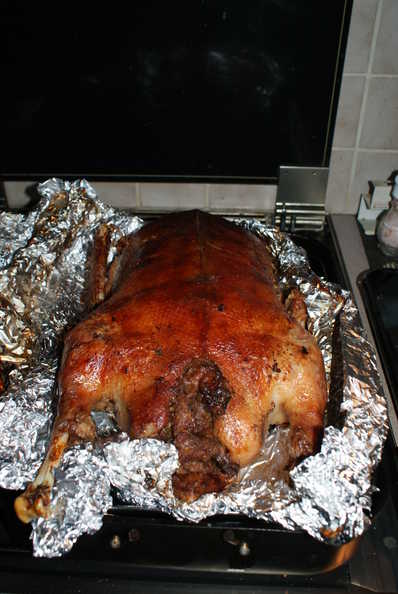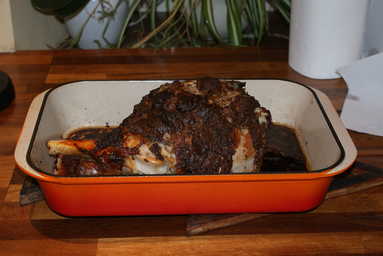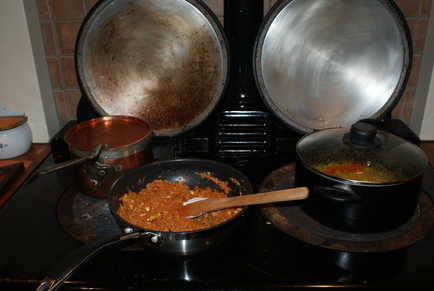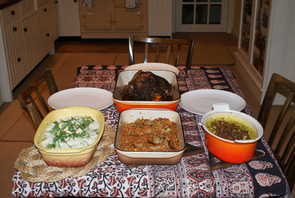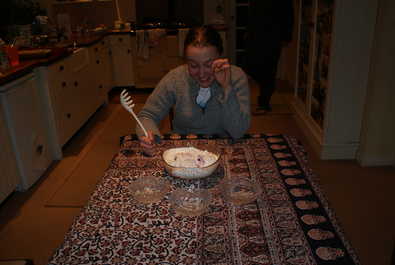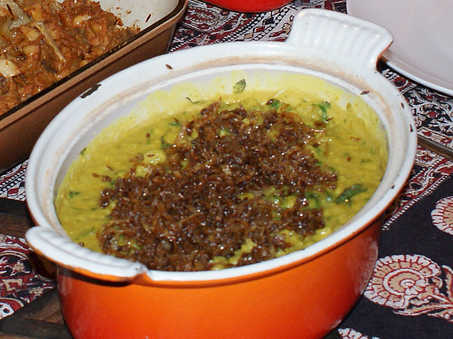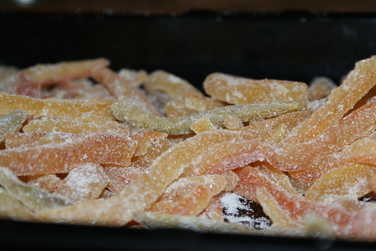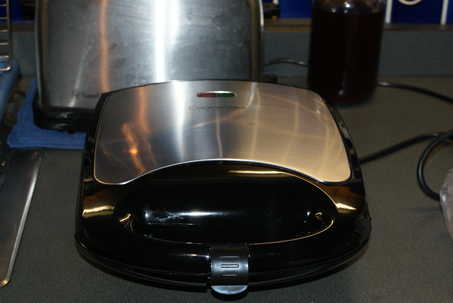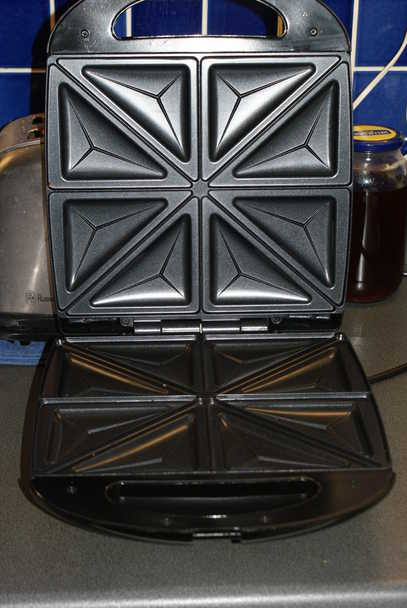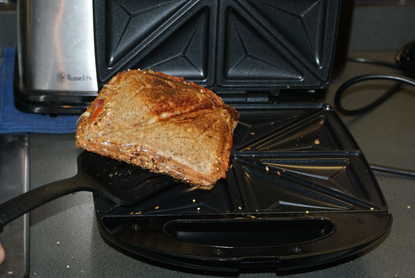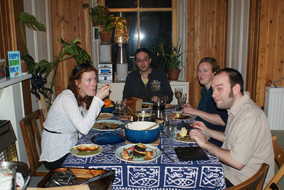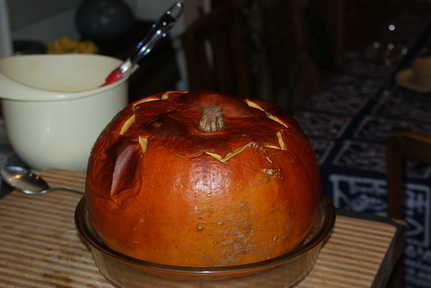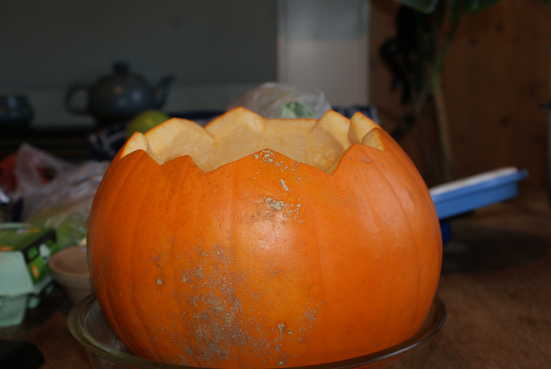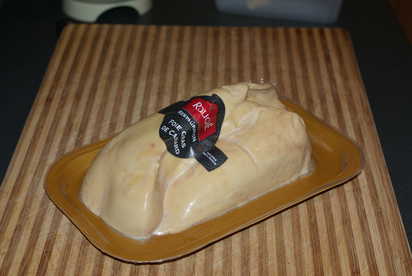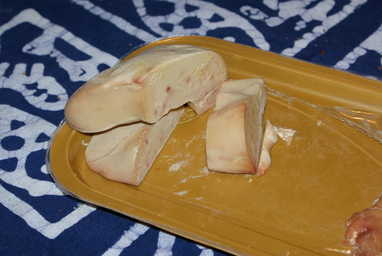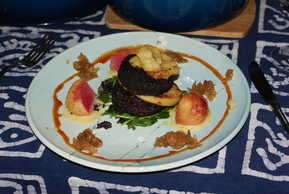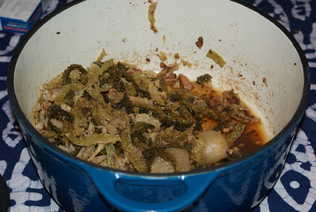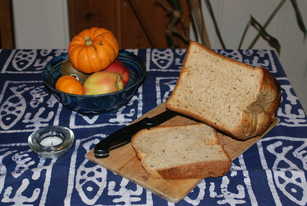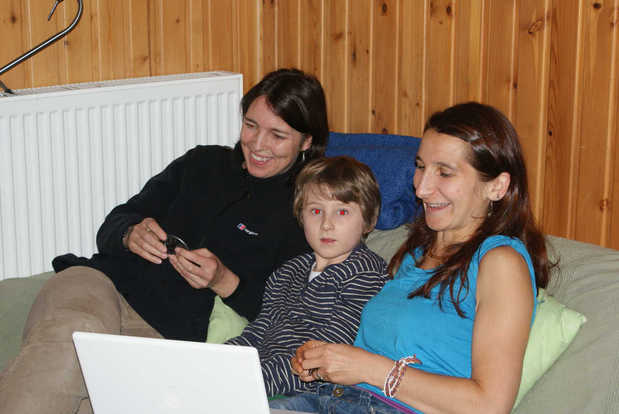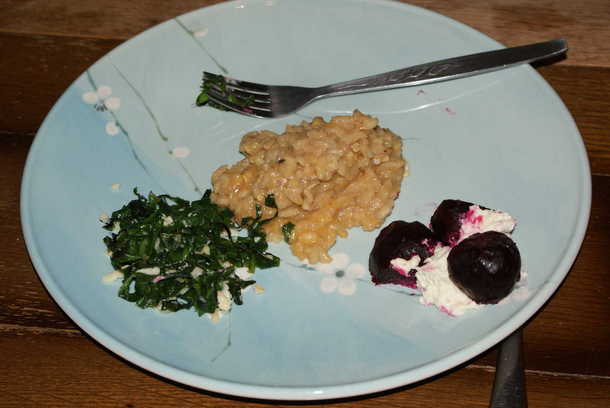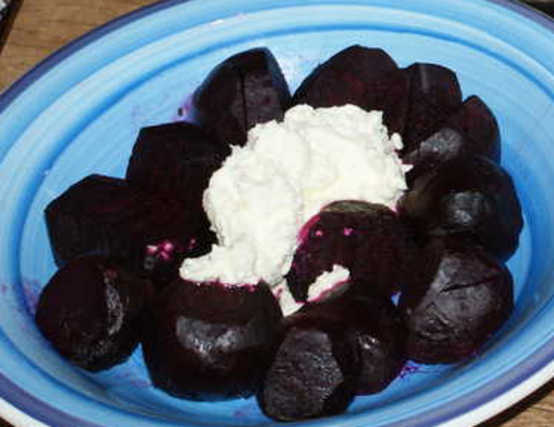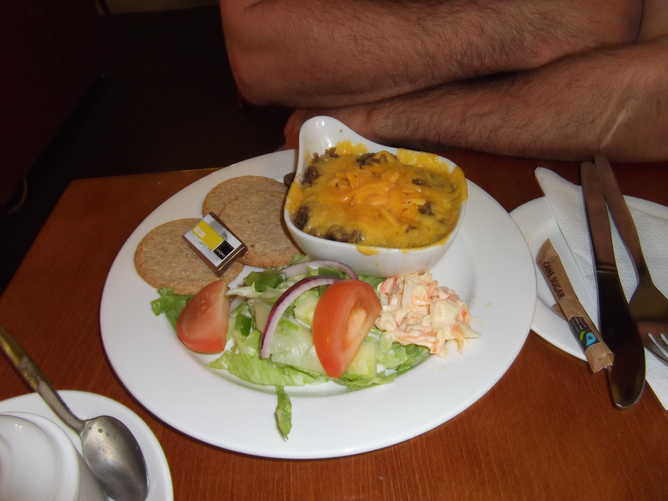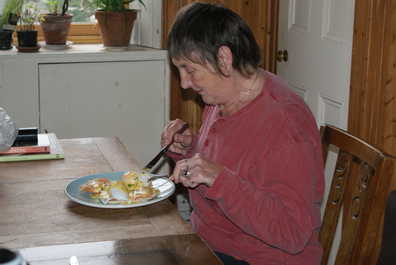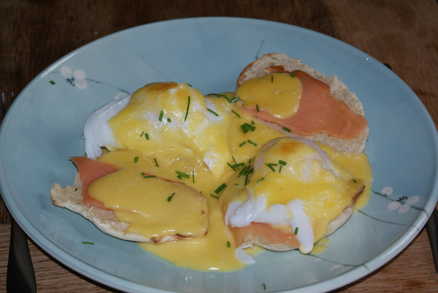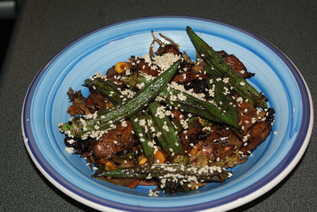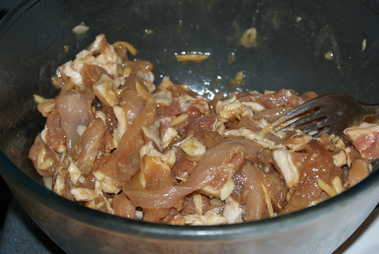
Fiesta Peruana

Today one of those painfully earnest middle-class middle-aged knightsbridge women on Radio 4's Woman's Hour taught me how to pronounce quinoa - like the cry of a Tourette's baby: 'kin WAH!.
Useful stuff, and just in time for the latest visit from Aline, my cute landlady, and another excuse for a (distinctly wholemeal) knees-up.
Aline loves to spend her time hanging out in Amazonian tree-tops, and since she's been trapped indoors for many months now writing up her foot-thick doctoral thesis, it's definitely time to break out and Party Party Peruvian Styley!
It's turned out to be our biggest gathering yet - partly 'cos almost everyone we invited actually showed up for a change you know who you all are and partly 'cos we also made it a surprise birthday party for Aline's friend Anuschka not that it stopped us forcing her to skivvy for us in the kitchen. So her friends had to come. Hah!
Twenty three people to feed and water - so we went buffet style, mostly cold food which seems to be quite the Peruvian thing, and just a couple of hot stews: One meat and one of those 'kin WAH things - an Inca favourite. Allegedly.
I played only a minor role in the cooking this time - I catered for the non-vegetarians with a pork adobo and a rack of crackling, I under-cooked some peruvian-style rice to go with, and then busied myself with jugs of Cuban Mojitos to get the cocktails rolling.
OK, not exactly authentically Peruvian, and we had planned on more native Pisco sours, but they're kind of fiddly to prepare and we had only limited amounts of Pisco, so we decided to save those for later when things had relaxed a little and we had some time to ge the food processor out.
Pretty hard stuff to get - Pisco. A kind of Peruvian grape poteen, with a fairly distinctive odor of herbal sweat, it's not widely stocked, though you can order it on the internet for around £25 (promptly delivered too I have to say). Or you can buy it from Harvey Nichols for £105 [Tamaya's Gran Pisco is sadly no longer available there :( ].
You do the math.
The sours went down rather smoothly, when they finally put in their appearance, but I guess the party was pretty much drunk out by that point, because we ended up with half a jug that we just couldn't get rid of, not helped by Jenny's mum Liiisa refusing to have anything to do with them!
So I stuck the leftovers in my ice cream machine's ready-frozen sleeve and put it straight back in the freezer. I thought it might freeze smoothly without needing to be stirred being mostly egg white foam. But I was wrong. The result is a crunchy frozen Pisco mousse. Not awful, but no substitute for ice cream I'm afraid.
My Mojitos, meanwhile, met with almost universal female disapproval. Too sour apparently. I reluctantly muddled in more sugar. Still too sour. So I added a bit more sugar. Then still more sugar. Finally the girls were drinking slightly alcoholic sugar syrup and still complaining, and when we collected all the glasses at the end to wash what did we find at the bottom? Yup - a thick sticky layer of undissolved sugar.
Lady wussies. They should stick to their Baileys!
Still it seems there are advantages to having a party for mostly teetotal, non-smoking, vegetarian, mothers. They didn't completely trash the joint and they all went home at a reasonable time. Dammit - I must be getting old!
Speaking of glasses - how is it that despite laying out a whole stock of paper plates and plastic knives, forks, and cups, every single piece of cutlery and crockery that we own ended up dirty?
I guess we failed to padlock them away!
I was going to make some deep-fried fritter-like things for pudding half-way throught the party, but was overcome by an attack of common sense and for once we ended up making absolutely all of the food in advance.
Bonus!
Here are the few simple dishes we made to entertain the masses:
menu
Cold Courses
Mushroom Ceviche
Haddock Ceviche
Causa Rellana - vegan style
Quinoa Stew
Sweet Potatoes
Boiled sweet corn
Hot Stuff
Adobo de Chancho
Pork Crackling
Peruvian Rice
Pudding
Mazamorra morada
Picarones
Drinks
Pisco Sour
Mojitos
Mushroom Ceviche
Haddock Ceviche
Julia's contribution - and tons of it too!
Causa Rellana - with tuna fishCausa Rellana - vegan style
Quinoa Stew
Sweet Potatoes
Boiled sweet corn
Hot Stuff
Adobo de Chancho
Pork Crackling
Peruvian Rice
Pudding
Mazamorra morada
Picarones
The pudding which never happened.
Birthday Cake
Made using Clare's Gluten-Free Brownie recipe.
Drinks
Pisco Sour
Mojitos
We borrowed a handy bilingual book of Peruvian cuisine from Aline's friend Julia who was also good enough to bring along the haddock ceviche, Which she didn't make following the book. Slightly suspiciously I thought? and Aline did a good job of trawling the web for vegetarian-friendly versions of peruvian classics, making good use of a site called, appropriately enough, Peru Food
And a good time was had by all.
All that's left is for Aline to sober up, bind her massive thesis and get a real job!
Comments (0)
Season's Eatings

Yes, once again 'tis the season to stuff your bird and stuff your face.
We like a traditional goose for the Christmas bird in our house; lovely succulent meat, never dry. Plus you get about a year's worth of beautiful fat for your roasties. Anyway, if it was good enough for the Cratchits it's good enough for us!
Following our traditions I picked the stuffing and the starter. I quite liked the sound of Nigella's gingerbread stuffing so we went with that. We were slightly worried that it might turn out too sweet, so we replaced some of the gingerbread with regular bread, but to be honest it was still a bit overwhelmingly sweet and sticky. I think I might go back to something a bit more traditional next year.
Unusually this year we also had a roast duck.
Since my brother decided to have himself a family we are now forced to get dressed (get dressed! On Christmas day! The horror!) and treck the mile upon mile (yes: two miles) to his place for Christmas Dinner. So fearing there wouldn't be enough leftover bird to feed two families for one entire day, Mum and I decided to have a second Christmas dinner at home on Boxing day with a duck. We were taking no chances.
For starters we made up some of Aidan's goats cheese parcels, which seemed to travel well when Aidan brought them around to my place, but unfortunately Mum ignored all my careful instructions on how to cut up the cheese and instead mashed it to paste before I got the chance to stop her. So they were a bit soggier than I had hoped.
main fowl
A couple of things I relearned this Christmas about making gravy:
- If you make sure to keep some water in the bottom of the bird's roasting tin you'll get a nice rich dark stock under the layer of fat to make your gravy with. Without the water you might just end up with a burnt crust and unusably bitter fat.
- Gravy thickens with between 1 and 3 tablespoons of flour fried in an equal volume of fat for each pint of liquid. So a litre of gravy needs 2 tablespoons flour for thin and up to 6 tablespoons for extra thick gravy. If you're using cornstarch then you'll only need about 2 teaspoons per pint.
- You can finish your gravy with a variety of flavours:
- orange juice ideally a mandarin such as satsuma, clementine, or tangerine, lemon juice, or zest from either
- port or red wine, Madeira, Marsala, white wine or even cider probably best used to deglaze the roasting tin
- any other liquor or brandy
- Worcestershire sauce or mushroom ketchup
- mustard
- spices, tomato purée or ketchup possibly best fried with the flour
- redcurrant jelly, jam, or other preserve
- garlic and anchovies apparently!
- marmite or bovril if you're a complete philistine
- a whisk of butter to add a little gloss
- Apparently bird roasting times can actually be dramatically less than the standard 20 minutes per pound recommended by cookery writers since the dawn of time. Felicity Cloake even claims to have cooked a 6kg turkey in just two hours - unlikely as that seems. I have to say though, that the low temperature roasting times for our goose were pretty much as advertised. And we used a meat thermometer and everything.
Ingredients:
It's a bitter-sweet meal - marking as it does the end of Christmas. The delicious end of Christmas.
Nothing left after that but to start working on those leftover mince pies.
Roast Duck
main fowl
Our 6lb duck was just perfect after 2½ hours cooking,
with the last half hour at a slightly higher temperature to crisp it up.
Serves 4
Ingredients
- 1 duck
- herbs, garlic or fruit for stuffing optional
Pre-heat the oven to 220°C/425°F/Gas Mark 7.
Untruss the duck and remove the wing tips (if present).
Prick (or slash) the duck skin all over, at about 1" spacing. Make sure to pierce through the skin into the fat layer, but don't penetrate the bird's flesh. This is to make sure that the fat runs out and leaves the bird with a nice crispy skin, without losing any of the meat juices.
Reduce the heat to 180°C/350°F/Gas Mark 4 after 15 minutes or so once the fat has started to crackle, and cook the bird for about 20 minutes plus 20 minutes per lb, basting every 20 minutes or so if you like, or the skin is looking a bit dark.
You can turn the temperature back up again for 20 minutes at the end to get the skin crispy and golden.
Untruss the duck and remove the wing tips (if present).
Prick (or slash) the duck skin all over, at about 1" spacing. Make sure to pierce through the skin into the fat layer, but don't penetrate the bird's flesh. This is to make sure that the fat runs out and leaves the bird with a nice crispy skin, without losing any of the meat juices.
If you like you can render away more of the excess fat to start with by either steaming the bird over boiling water for half an hour,
or simmering it up for 30 minutes with herbs and vegetables as for making stock.
Pat the bird dry before carrying on with the roasting process.
Rub the skin with salt and pepper and place the duck uncovered, breast up, on a rack over a roasting tin containing a little water (or wine!)
(to stop leaking juices from burning so you can use them to make a nice dark gravy).Pat the bird dry before carrying on with the roasting process.
Reduce the heat to 180°C/350°F/Gas Mark 4 after 15 minutes or so once the fat has started to crackle, and cook the bird for about 20 minutes plus 20 minutes per lb, basting every 20 minutes or so if you like, or the skin is looking a bit dark.
If you like you can turn the bird a couple of times too - we started the bird on it's breast then flipped it onto it's back about halfway
- but I'm not convinced it's necessary.
The bird is ready when the juices run clear when penetrated between thigh and breast
and the temperature of the thickest part of the bird reaches 75°C/165°F.You can turn the temperature back up again for 20 minutes at the end to get the skin crispy and golden.
You don't really want to stuff a duck as it will suck in too much fat, but feel free to throw a handful of herbs,
garlic, tart cherries, orange or lemon rind or pieces into the cavity to infuse a little flavour.
Gingerbread Stuffing
ingredient side
This makes an edible but very sweet, dense, heavy stuffing.
Very sweet.
A bit too sweet if you ask me.
It might be worth trying with regular bread replacing some of the gingerbread, but I think I'll be doing a different stuffing this time next year.
Very sweet.
A bit too sweet if you ask me.
It might be worth trying with regular bread replacing some of the gingerbread, but I think I'll be doing a different stuffing this time next year.
Fills 1 Goose
Ingredients
- 500g (3 medium-sized) onions
- 2 eating apples, peeled and cored
- 45g butter
- 1 x 15ml tablespoon vegetable oil
- 750g streaky bacon
- zest of 2 clementines/satsumas
- 2 x 400g gingerbread loaves (such as McVitie's Jamaica ginger cake), loosely crumbled
- 2 eggs, beaten approx.
- ½ teaspoon freshly ground pepper
Using a food processor or by hand, finely chop the onions and apples.
Put the butter and oil in a large, wide saucepan over a medium heat and fry the chopped onions and apples until soft, about 10-15 minutes.
Finely chop the bacon in the processor, or by hand, and add this to the softened onion and apple mixture. Cook everything, stirring frequently, for about 5 minutes more.
Add the zest of the clementines/satsumas.
Take the pan off the heat and let it cool a little before mixing in the gingerbreadcrumbs. You can let this get properly cold now if you want.
Just before you want to cook the stuffing, add the beaten eggs and pepper,and use it to stuff the cavity of your bird, or cook all of it (or what's left after stuffing your bird) in a buttered baking dish. I don't stuff the bird but put all of my stuffing in a very generously buttered old Le Creuset terrine, with internal dimensions of approx. 25cm x 9cm x 7cm deep.
Bake it in a hot oven (200°C/gas mark 6) with your turkey for about the last 45 minutes. If the stuffing's going into a full oven - which it no doubt is - there should be no need to cover the dish. If the oven is less full, and therefore hotter and less steamy, you could cover with foil for the first 30 minutes.
Let the cooked stuffing sit in its terrine for a good 10 minutes out of the oven before turning it out and slicing it. Or just spoon from the dish if that's less stressful. (I love a slice of this, cold, in a Christmas night or Boxing Day turkey sandwich.)
Put the butter and oil in a large, wide saucepan over a medium heat and fry the chopped onions and apples until soft, about 10-15 minutes.
Finely chop the bacon in the processor, or by hand, and add this to the softened onion and apple mixture. Cook everything, stirring frequently, for about 5 minutes more.
Add the zest of the clementines/satsumas.
Take the pan off the heat and let it cool a little before mixing in the gingerbreadcrumbs. You can let this get properly cold now if you want.
Just before you want to cook the stuffing, add the beaten eggs and pepper,and use it to stuff the cavity of your bird, or cook all of it (or what's left after stuffing your bird) in a buttered baking dish. I don't stuff the bird but put all of my stuffing in a very generously buttered old Le Creuset terrine, with internal dimensions of approx. 25cm x 9cm x 7cm deep.
Bake it in a hot oven (200°C/gas mark 6) with your turkey for about the last 45 minutes. If the stuffing's going into a full oven - which it no doubt is - there should be no need to cover the dish. If the oven is less full, and therefore hotter and less steamy, you could cover with foil for the first 30 minutes.
Let the cooked stuffing sit in its terrine for a good 10 minutes out of the oven before turning it out and slicing it. Or just spoon from the dish if that's less stressful. (I love a slice of this, cold, in a Christmas night or Boxing Day turkey sandwich.)
Sweet and sticky, just like Nigella.
Snowed In Sunday

I Went to visit Doctor Jenny in the arctic wastes of Dundee this weekend.
She's been assiduously trying to lure me up there for weeks now with the promise of fine dining in the Bridgeview Station Restaurant that she's discovered. There may be ulterior motives however - Jenny's new cottage has an AARGA and she's been trying to figure out how to actually use it for anything other than burning toast, so I said I'd bring up something to cook in it.
After she told me some horror stories about roasting a chicken for 6 hours, I decided to make a Raan - since it's already marinated in yoghurt to break down the fibres and soften the meat I figured it would be the most forgiving of time and temperature. Jenny bought an oven thermometer and reckons that here AARGA sits sullenly around 180°C, so I figured a good 3½ hour roasting would do for the joint, plus half an hour R&R (for the joint, not for us. Jenny's not that kind of girl).
AARGAs are funny things. Massive iron blast furnaces of undeterminate and uncontrollable temperatures, Jenny's AARGA started off too hot for the slow cooking of the Leg of Lamb, and ended up too cool to simmer beans. Jenny's AARGA also has only two hobs on top that, though large, are not quite large enough to cook more than half of two pans at the same time.
Since most of my cooking involves frantic last-minute frying that became a bit of a problem, so I had to schedule the hob-work more carefully than usual.
Fortunately keeping things warm is the AARGA's speciality.
On Thursday afternoon I bought a nice leg of lamb from a friendly butcher near my work, having clearly forgotten that legs of lamb are now obscenely expensive. Of course I could have bought a leg sealed into heavy duty plastic bag along with a pint of blood and what looks like semen from a not-so-local supermarket for slightly less, but one does what one can for the remaining independent shops.
I made up a quarter batch of tandoori paste, burnt it whilst frying, threw it away, made up another quarter batch of tandoori paste, then smeared up my Raan and sealed it in about 20 plastic bags before putting it in the boot of my car.
Now my car smells like an Indian takeaway.
I also planned a Kalpna Bainghan Bharta which goes quite well with the leg of lamb, and uses up some of the leftover tandoori paste too. So I puréed up a batch of onions, garlic and ginger to take with me.
You can never be sure what you'll find in Jenny's house.
I figured I'd decide what staple (rice/chapatis/naans) and other dishes I'd make when I got there, and I went for rice (Jenny had a jar of long-grain rice) and a dal (Jenny had a jar of green lentil-pea-things).
We got the lamb in the top oven (uncovered) at 4 o'clock (optimistically announcing dinner for eight), went shopping (Jenny loves shopping), Put the pricked and greased aubergines and onions in the oven about 5:30, got the dal simmering about 6:00 and started frying up the Bharta (which took quite a long time).
I cooked up the rice in some ghee to nicely coat the grains, simmered them covered with twice their quantity of water and a little salt, squeezed onto one of the hobs for five minutes or so until the water had disappeared to the level of rice, then stuck it into the AARGA's warming oven at about 7:15.
The lamb came out to rest at 7:30 (so far so on time!), the augergine and tomatoes went into the bharta and I started frying up the tarka to finish off the dal. Unfortunately after so much cooking effort the poor AARGA had cooled off to tepid, so the tarka took rather longer to caramelize the onions than I had anticipated, and the dal wasn't finished until 8:30. Still, the rice, bharta and raan went onto the table at 8:00 sharp.
Another partial success!
For dessert we used some of the meringues I had left over from Stir-up Sunday (and which I had re-baked to try and dry them out some) to make a messy Eton. And we learned that it isn't a good idea to mix in the meringues too early lest they dissolve completely into the cream and fruit.
Bugger.
We had planned a nice balmy 707 sail on Sunday, so we got up at 7:00 to set off in good time.
We had not planned on finding the first snows of winter piling up on Jenny's doorstep and covering all the land, and we had not planned on getting trapped on a steep icy hill with sliding cars blocking our progress ahead and behind. Eventually after a Landrover appeared and towed the cars out of our way, we gave up and returned to Jenny's for a second breakfast.
So we discovered two things:
- Jenny was wise to have just bought a 4x4 if she ever wants to leave her home in the winter months.
- 4x4 vehicles are not magic, and may still do massive skids narrowly missing trees and drainage ditches if you take icy corners too fast.
Hey - I get my jollies where I can!
Dal
curry side veg
Spicy Indian lentil soup
Here's a Dal I made up from the stuff at the back of Jenny's cupboard.
Obviously you can use any legumes you like, with any spices you like - I fancied the small jar of aniseedy powder I found labelled 5 spices though it wasn't any I recognised.
You can also add any vegetables you like to the lentils (cauliflower, potatoes, tomatoes), use any flavoured liquid (stock, coconut milk, juice, wine), and fry tomato purée with your tarka if you fancy.
There are probably as many Dals in the world as there are lentils.
Ok, pans of lentils.
Obviously you can use any legumes you like, with any spices you like - I fancied the small jar of aniseedy powder I found labelled 5 spices though it wasn't any I recognised.
You can also add any vegetables you like to the lentils (cauliflower, potatoes, tomatoes), use any flavoured liquid (stock, coconut milk, juice, wine), and fry tomato purée with your tarka if you fancy.
There are probably as many Dals in the world as there are lentils.
Ok, pans of lentils.
Serves 8
Ingredients
- 2 cups lentils/beans/peas I used some un-labelled split green peas. Though they might have been green lentils
- 2-3" fresh ginger, peeled, sliced into fat disks
- 2-3 fresh chillies, whole or sliced
- 1 teaspoon turmeric
- 2-3 cloves garlic, peeled, crushed
- ½ teaspoon salt
For the Tarka:- 6 cardamom seeds
- 1 teaspoon cumin seeds
- 1 teaspoon mustard seeds
- 2 onions or equivalent shallots, thinly sliced
- 1 teaspoon that aniseedy mixed-spice powder you found at the back of the cupboard
To Serve:- spoonful or two of yoghurt, or lemon juice, or vinegar
- fresh coriander to serve
Wash your lentils well and pick over to remove any boulders.
Cover with water in a fairly large pot and bring to the boil.
Skim away any foam which rises, then add the slices of ginger, crushed garlic cloves, chillies deseed a couple of chillies and slice them in if you want the Dal hotter, and simmer gently for 1-2 hours depending on the lentils. You want the beans to be on the verge of falling apart.
To Serve:
Before serving make the Tarka:
Heat a couple of tablespoons of ghee and add the cardamom seeds for a bit, then the smaller seeds until they sizzle and release their aroma.
Add the sliced onions and fry gently until they turn golden and caramalize this can take a while - watch they don't burn!
Meanwhile crush up some of the lentils in the pan to make a bit of sauce, adjust the consistency with more water if necessary,
adjust the salt, add some yoghurt and chopped coriander and stir through.
When the onions are ready, add the powders, stir briefly, then pour the hot Tarka over the lentils so it sizzles, and cover to contain the delicious flavours.
Warn your guest not to eat the whole cardamoms or ginger slices. Unless they want to.
Serve.
Cover with water in a fairly large pot and bring to the boil.
Skim away any foam which rises, then add the slices of ginger, crushed garlic cloves, chillies deseed a couple of chillies and slice them in if you want the Dal hotter, and simmer gently for 1-2 hours depending on the lentils. You want the beans to be on the verge of falling apart.
To Serve:
Before serving make the Tarka:
Heat a couple of tablespoons of ghee and add the cardamom seeds for a bit, then the smaller seeds until they sizzle and release their aroma.
Add the sliced onions and fry gently until they turn golden and caramalize this can take a while - watch they don't burn!
Meanwhile crush up some of the lentils in the pan to make a bit of sauce, adjust the consistency with more water if necessary,
adjust the salt, add some yoghurt and chopped coriander and stir through.
When the onions are ready, add the powders, stir briefly, then pour the hot Tarka over the lentils so it sizzles, and cover to contain the delicious flavours.
Warn your guest not to eat the whole cardamoms or ginger slices. Unless they want to.
Serve.
Tasty.
I quite liked the touch of yoghurt to lift the flavours.
I quite liked the touch of yoghurt to lift the flavours.
Stir-Up Sunday

Did you know today was Stir-Up Sunday?
I did. It's when all good Christians get the whole family together to stir their Christmas puddings. I volunteered my services to the Eldorado clan but they weren't interested. Even disgusted. Apparently Christmas puddings break their No Raisins rule.
Another one for the list.
Pity - I had hoped to rope them into stirring up a rather special batch of old-fashioned mincemeat. Once upon a time mincemeat used to be made with real minced meat. And for a year now I've fancied having a go at recreating this tradition. Full of good intentions, I had already bought myself some lean venison mince from my favourite butcher (imagine how much easier that would have been with my own mincer/sausage machine? Eh family? Eh?) in anticipation of getting it on, but without the spur of sweet domestic kinship I couldn't be bothered to start what I realised was going to be quite a lengthy process given that I planned on candying my own peel too.
Ah tradition. Without you we are weak!
So I picked through my venison stripping out as much fat as I could, covered it with 1½ cups of cognac, and stuck it in the fridge to wait for me to get my arse in gear. Which eventually started on Tuesday, when I boiled up my candied fruit peel and finally used up all the egg whites left over from making ice cream to bake an oven-load of meringues just in time for Flora's scheduled Toastie Evening.
I suppose I ought to explain - Flora has a new Toastie machine, and has been wanting to show it off, so she brought it round along with half the contents of her parents' fridge and we loaded it up until we couldn't eat any more.
So we had two rounds of toasties:
Chicken Supreme
I wrapped some thawed-out chicken breasts in bacon and fried them up,
whilst I softened some sliced onions together with diced mushrooms and a sliced red pepper,
then made it into a sauce with cream and grainy mustard.
and Goats Cheese and Proscuttio
with sliced tomatoes.
The chicken supreme toasties were far too dry
(though they were improved by a dash of Worcestershire sauce)
but the goats cheese filling was rather tastyAnd then we had Eton Mess. Or maybe Citrus Fruit Mess. Since I had a load of leftover citrus fruits - what with making all that candied peel. I just cut up the fruit into bite-sized pieces (already handily peeled), sugared them, whipped some double cream until it was thickening (but not stiff), and stirred it through the fruit and broken bits of meringue.
The dessert was reasonably acceptable, but I'd still go for strawberries, indeed I will shortly.
Flora really liked the candied peel and took a bunch home. Which was fine since I seem to have made about a pound of the stuff, despite needing only 1½ oz!
Come Thursday when I started preparing for a visit to Doctor Jenny the candied peels had dried out nicely so I went ahead and made up my real mincemeat (finally!) poured in an extra fl oz of cognac, covered it with cling film and left it in a tupperware container in the fridge.
So more Stir-Up Thursday really.
Black Pudding And Foie Gras

Last Christmas Mum got me the delightfully plush Black Pudding & Foie Gras cookbook. I've fancied trying out its eponymous dish for a while now, and finally got around to it this weekend.
As well as a couple of staple guests, I also had a full set of Alexes:
Ex-Jenny Alex is an old friend and lives just round the corner, which makes it all the more embarrassing that I rarely see him. Work-and-play-mate Alex is someone I visit regularly but have felt guilty for some time about not returning the favour and inviting him over.
So a great opportunity to make some amends.
Foie Gras being roundly despised these days and illegal to produce in Britain (though personally I think that unlike Lance Corporal Jones' Dervishes those saucy French Geese just love it up 'em), it's a bit hard to get hold of. But it's my second favourite food so it's worth making the effort. Fortunately George Bower came through with the goods. A snip too at a mere £30. Oooh. Taste the suffering.
So, what to serve it with?
Well I have a giant pumpkin left over from Hallowe'en, so that's the soup sorted. Thanks Chef Bocuse!
I made a loaf of bread machine red onion, thyme and rosemary bread, and a bowl of Earl Grey flavoured pumpkin seeds to prevent Flora from passing away before the meal arrived.
I baked some potatoes to make plain mash, braised a Savoy cabbage, and in keeping with the autumnal theme I decided to experiment with a pumpkin ice cream for dessert too. But as per usual all the supermarket pumpkins had turned into golden coaches or something at the stroke of Hallowe'en and driven off.
So I used butternut squash instead.
Which was probably better to be honest.
Despite being able to get the soup, baked potatoes, braised cabbage and dessert organised well in advance as planned, serving up the main course was still a bit hectic. It takes a some time to assemble each plate of goodies, and it doesn't help having lots of things which need frying just before serving. Typical shoddy planning on my part - though it is somewhat the nature of the dish. Fortunately the black pudding and the caramelised apple slices keep warm quite well, and with a bit of help from ex-Jenny Alex peeling the puddings unlike the real and original (Lancashire!) intestinal black pudding, Scottish versions are bizarrely shrink-wrapped in plastic and mashing the baked potatoes whilst work-and-play Alex documented the proceedings in 3D! we managed to get things out in a reasonable time frame. Maybe work-and-play Alex will post his videos for our entertainment at some point?
It probably helped that everyone was already stuffed with cheesy cream soup.
After throwing the croutons into the waiting soup and ladling it up, I had time to reheat the cabbage then stick it in the oven to stay warm, boil up a little milk to reheat the mashed spuds, and should have taken the opportunity to stick the scrumpy reduction and apple chutney in the oven too to keep them at the ideal temperature. As it was, the chutney was a bit too cold, and the reduction a bit too hot (and consequently runny).
After that it was just frying, frying, frying.
Update!
Work-and-play Alex has published some of his 3D party pictures!I reproduce a couple here - if you squint really hard at the pairs of pictures until the dots in the middle merge they will literally jump out of the page and smack you in the face.
Or at least, that's why I assume I now have this massive headache!
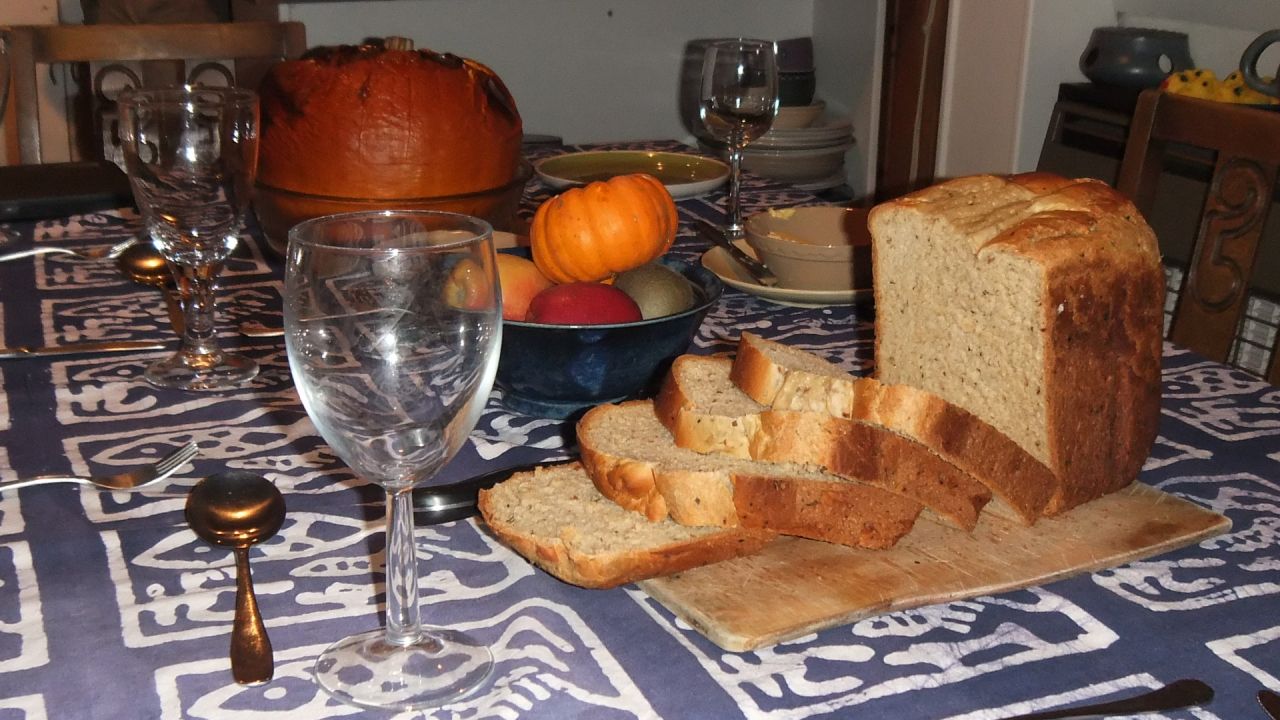
|
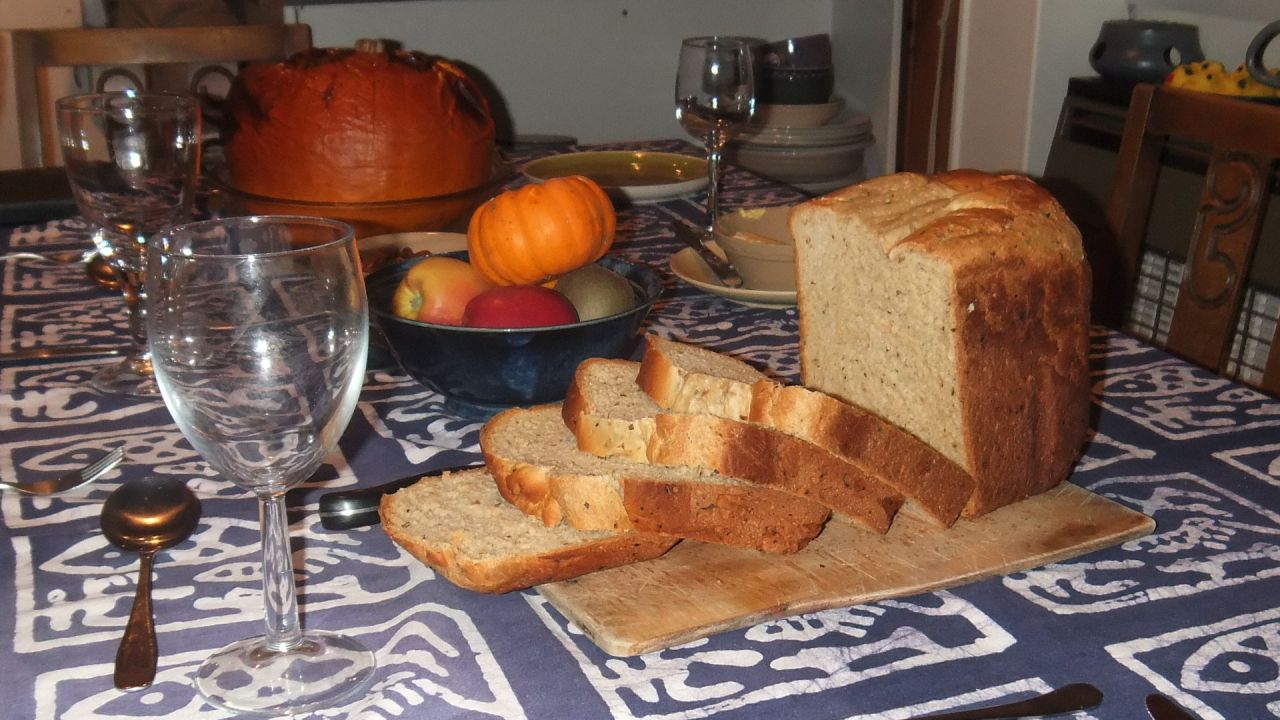
|
| • | • |
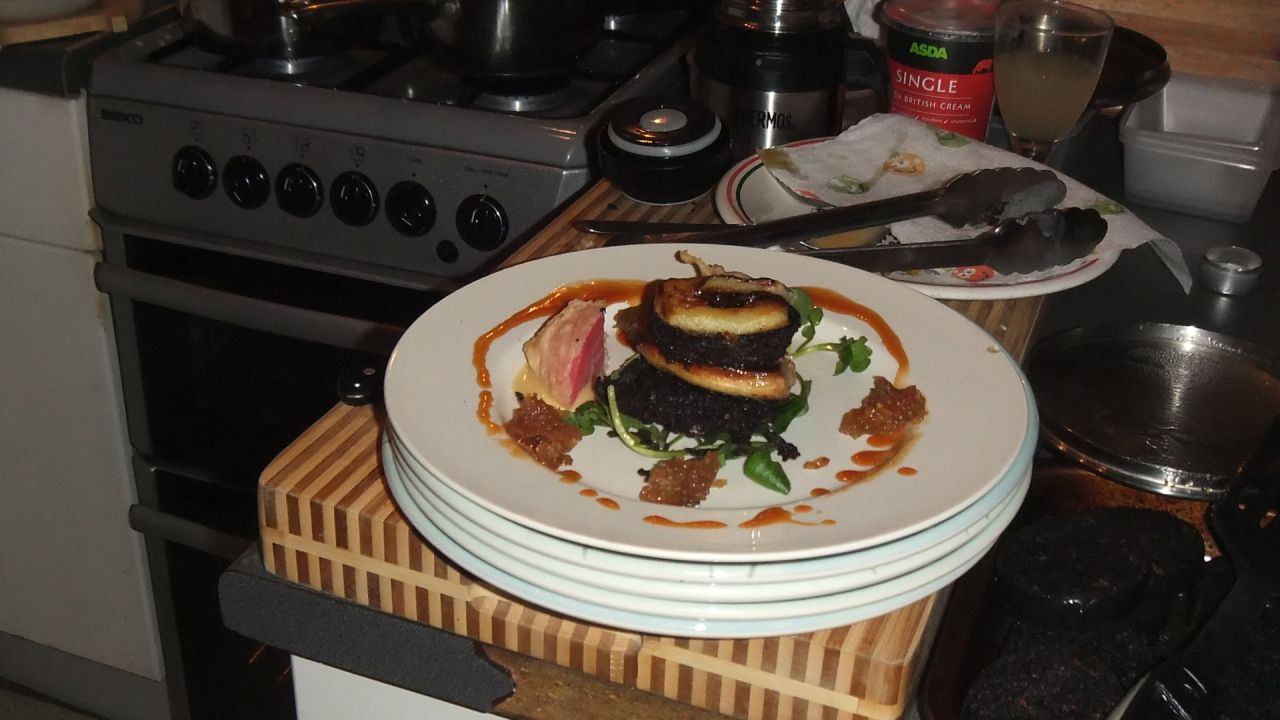
|
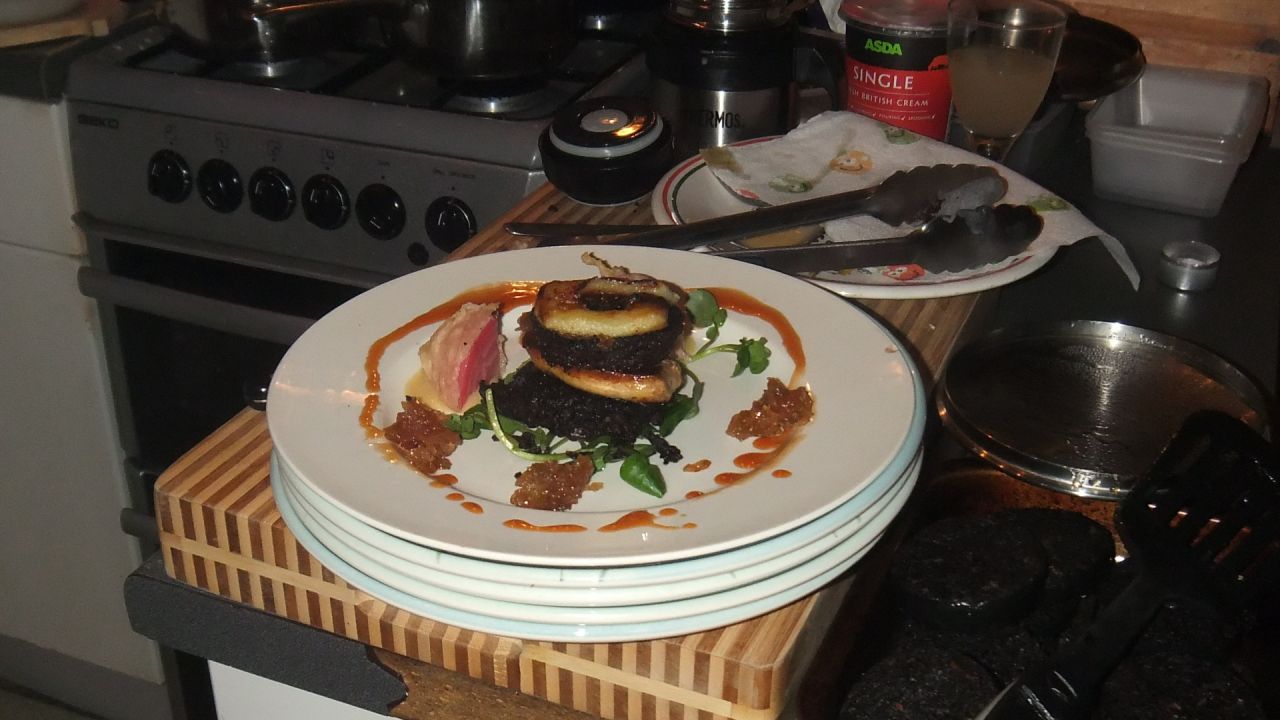
|
Braised Cabbage In Cider
side
Inspired by a Roux Brothers recipe
Serves 4
Ingredients
- 1 medium Savoy cabbage, about 1½lb (750g)
- drizzle of olive oil
- pinch or 3 of caraway seeds maybe juniper berries or cumin, onion or fennel seeds might work?
- 3½ oz (100g) thick smoked bacon slices, rind removed
- 7 oz (200g) shallots, peeled and left whole
- 1 granny smith, peeled, chopped
- 2 clove garlic, peeled and crushed
- 100ml (about ⅓ bottle) cider
- salt and freshly ground black pepper
Preparation
Pre-heat the oven to gas mark 6, 400°F (200°C).
Trim any coarse or damaged leaves from the cabbage, then cut it into quarters. Slice away the hard central stalk and shred the remaining cabbage into 1cm strips. Rinse in cold water and drain thoroughly in a colander.
Cut the bacon into 1cm strips.
Heat the olive oil in a heavy casserole and fry the caraway seeds until they release their aroma.
Add the sliced bacon and the shallots. Fry until the onions are starting to colour.
Meanwhile peel and core the apple and cut into 1cm cubes. Add to the pan with the crushed garlic.
When the apple has begun to caramelise, add the cabbage and stir around to coat with oil, then add the cider and bubble it off a little while you scrape the bottom of the pan.
Season with a little salt and some black pepper.
Serve hot.
Pre-heat the oven to gas mark 6, 400°F (200°C).
Trim any coarse or damaged leaves from the cabbage, then cut it into quarters. Slice away the hard central stalk and shred the remaining cabbage into 1cm strips. Rinse in cold water and drain thoroughly in a colander.
Cut the bacon into 1cm strips.
Heat the olive oil in a heavy casserole and fry the caraway seeds until they release their aroma.
Add the sliced bacon and the shallots. Fry until the onions are starting to colour.
Meanwhile peel and core the apple and cut into 1cm cubes. Add to the pan with the crushed garlic.
When the apple has begun to caramelise, add the cabbage and stir around to coat with oil, then add the cider and bubble it off a little while you scrape the bottom of the pan.
Season with a little salt and some black pepper.
You can pause at this stage if you don't need the cabbage just yet.
Just reheat it back up on the stove when you're ready to continue.
Put on the lid and transfer to the oven for about 30 minutes,
until the shallots and cabbage are tender.Serve hot.
Really good. Though the colour can be rather dull unless you pick nice dark cabbage.
Red Onion Bread with Thyme and Rosemary
bread veg
Thank God for bread machines!
I thinly sliced three red onions, threw in a tablespoon of chopped fresh rosemary, and gently caramelised them in a tablespoon or two of butter until golden and well reduced.
Then I mixed enough strong white flour to dry the mixture out so it wasn't too greasy looking, and added a tablespoon of roughly chopped thyme leaves.
Then I just followed my bread machine instructions for making Classic White Bread, and added my onion and herb mix when the machine angrily beeped at me demanding nuts, or raisins, or whatever you're supposed to add.
Despite mysteriously rising over-enthusiastically and sticking itself to the roof of the machine, spoiling the crust a bit, the bread was rather good.
I thinly sliced three red onions, threw in a tablespoon of chopped fresh rosemary, and gently caramelised them in a tablespoon or two of butter until golden and well reduced.
Then I mixed enough strong white flour to dry the mixture out so it wasn't too greasy looking, and added a tablespoon of roughly chopped thyme leaves.
Then I just followed my bread machine instructions for making Classic White Bread, and added my onion and herb mix when the machine angrily beeped at me demanding nuts, or raisins, or whatever you're supposed to add.
Despite mysteriously rising over-enthusiastically and sticking itself to the roof of the machine, spoiling the crust a bit, the bread was rather good.
Ingredients
- 3 red onions
- fresh herbs (rosemary, thyme)
- butter for frying
- extra flour for the onion mixture
For the bread:- scant 350ml milk
- 2 tbsp butter
- 1½ tsp salt
- 2 tbsp sugar
- 600g strong white flour
- 1 packet of dry yeast
Smoothie Party

It's my Birthday and I'd cry if I wanted to!
But instead I had a Smoothie Party with my cute landlady and a few of our friends. It seemed like a healthy alternative to drinking. Since I'm on the dry :(
Aline suggested it, and even bought me a smoothy cookbook for inspiration! I also sneaked a few ideas from the menu of a local bar at the recommendation of my fellow guests at Stasczi and Andrew's wedding over the weekend. Yep she's hooked another one. You go girl!
It might have been easier if I had a juicer (I'll add one to my gadget wish list), but the shopping was still unusually straightforward I have to say, mainly requiring the gathering of some attractive-looking fruit, random herbs, a few cartons of fruit juice, ice cream and some doughnuts.
Once upon a time most of my friends lived in The Haunted House; a fine Georgian town house in Newington, one of Edinburgh's earliest suburban villa developments.
The house had massive, oddly-shaped rooms packed with mysterious faux-egyptian furniture and furnished with huge onyx fireplaces. It featured servant's quarters, hidden staircases and hosted many atmospheric parties. It was at one such party that I (OK, maybe with a little help from my friends) invented the doughnut smoothie, which I decided would also be a feature of this smoothie party.
Hence the doughnuts.
As it turned out, the hardest things to buy were carrot juice you really need a wholefood shop, a reasonably ripe pineapple though most good supermarkets do carry an abundance of pineapples seemingly made from styrofoam. and a decent vanilla ice cream.
The massive ingredient lists on these commercial ice creams is truly dispiriting, I finally settled on Häagen-Dazs who rebelliously make their ice cream from... cream, milk, sugar and egg yolks.
Compare that with our own Scottish Mackie's who apparently believe that a Traditional Luxury Dairy Ice Cream is best pumped full of glycerine, fatty acid glycerides, sodium alginate and guar gum.
Oooh yum - that definitely says tradition to me.
Just in case the evening wasn't going to be liquid enough, and also because as usual for this time of year I have a couple of enormous pumpkin to use up, I made a big pot of good old-fashioned lactose-gluten-meat-fish-free pumpkin soup, and discovered crispy fried rice ball dumplings. Which I definitely plan on making again.
What with the not drinking and the not turning into a bacchanalian orgy my birthday party was a very family-friendly affair: Julia brought her 18-month-old monkey and Anuschka brought her spawn of the devil. At least - it's the only explanation I have for his evil red-eye in every single photo. To give the devil his due though, he really liked my doughnut smoothies.
That young devil can come again!
You would think, wouldn't you, that all that finely ground fruit would be fantastically good for you? And that you would would wake up the next day bursting with health and enthusiasm? Explain then, if you can, how I came to be so massively unwell next morning that I had to take the day off work and spend it sleeping. Finally waking up at 3 p.m. with a sore throat and a terrible pain in all the diodes down my left side.
What a waste of a holiday - I must have been ill!
Nothing for it but more liquid - and Aline kindly made me up a cup-full of her family's traditional flu remedy though she added extra cayenne as she felt I had probably built up more resistance to it than most.
I have to report that her remedy has quite a kick to it, and if you can manage to overcome your gag reflex and force it all down it feels like it might be doing some good. It certainly brought me out in a cold sweat.
As if not sweating enough had been my problem all along.
Aline's Traditional Flu Remedy
drink veg
As administered by Aline when I felt under the weather.
Be warned - it induces gagging.
Be warned - it induces gagging.
Serves 1 Invalid
Ingredients
- 1 clove garlic, crushed
- ¼ teaspoon cayenne pepper
- juice of 1 lemon
- honey to taste
- hot water
- a little ginger syrup optional
Roughly crush the garlic clove into a mug.
Add some ginger or ginger syrup if you like.
Add cayenne pepper to taste.
Pour over hot water.
Top with the juice of a lemon, honey to taste.
Administer.
Retreat to a safe distance.
Add cayenne pepper to taste.
Pour over hot water.
Top with the juice of a lemon, honey to taste.
Administer.
Retreat to a safe distance.
Yeuch!
Leftover Cheese Risotto

My Mum's visit left me with a fridge full of leftover cheese, some of it barely edible, that needed using up. So I invited Flora over for a cheesy dinner.
She brought her new footwear to show me.
Furry Boots?
On Flora's legs!
Apart from my staple Wyke Farm award-winning cheddar from Asda their most cheese-flavoured cheese, I couldn't resist some of Dobbies (not the house Elf - the one owned by fucking Tesco) 70% off specials on Old Amsterdam a fine mature Gouda Blacksticks Blue, Shropshire Blue and a rather nice Cave Aged Gruyère (I wonder if they have to take it to a special cave, or if cave is corporate Swiss for shed?)
Then Mum and I even added to the collection with a couple of smoked cheeses from our usual visit to Edinburgh's Farmers Market. You know, I keep buying stuff from the Farmers' Market - and I keep being enormously disappointed. This time was no exception. I bought some red onions that were half rotted, and some East Pier Smokehouse cheeses.
Well they might have been cheeses. They were cheese shaped anyway.
The Smokehouse advertises that it smokes the best Scottish produce and makes it better! which seems a terrible slur on Scottish produce. Our packages claim their contents to have once been Morangie Brie (from Ruraidh Stone at Highland Fine Cheeses) and a St. Andrews Anster.
Imagine if you took some smoke, and furiously pumped it into cheese-shaped moulds until it became solid. You'd have something like these cheeses. More or less inedible - they could just as well have been smoked foam rubber - but you can use them as flavouring if you like.
Smoke flavouring. If you don't happen to have any actual smoke.
Flora says it's time I checked out Stockbridge's new Farmers' market!
Edinburgh's Farmers Market notable exceptions, of course, are coffees from the Police Box Coffee Bars (which morphed suspiciously seamlessly from the now liquidated California Coffee Company ) and hog roast rolls from Oink.
It just goes to show that Farmers' Markets are all very well - but you can't beat the real thing: local shops regularly buying local products from local producers. You know, the kind of thing our high streets were full off before that fucking Tesco* arrived.
* [Insert favourite fucking supermarket here]
Leftover Cheese Risotto
main cheese
I made this using cheese I needed to get rid of, but you might actually plan it with a more suitable collection.
The smoked brie really worked very well, I'd have that again (and to be honest I wouldn't use it for much of anything else),
but the blue cheese was somewhat overwhelming.
I'd use less of it if I was making this again.
I served it with Culross Palace's finest leftover beetroots and horseradish cream. I also had some leftover spinach leaves which I stir-fried and served as a side-dish sprinkled with, yes, more leftover smoked cheese.
But I could have blanched them (or some spring greens) and stirred them through the risotto at the end.
These leaves were the diametric opposite of baby spinach leaves - and much more like kale. Quite an eye-opener actually. I've been shopping at fucking Tesco* for so long I've forgetting what real vegetables look like!
I served it with Culross Palace's finest leftover beetroots and horseradish cream. I also had some leftover spinach leaves which I stir-fried and served as a side-dish sprinkled with, yes, more leftover smoked cheese.
But I could have blanched them (or some spring greens) and stirred them through the risotto at the end.
These leaves were the diametric opposite of baby spinach leaves - and much more like kale. Quite an eye-opener actually. I've been shopping at fucking Tesco* for so long I've forgetting what real vegetables look like!
Serves 4
Ingredients
- 3-4 tablespoons butter
- 1 small onions or a few shallots, finely chopped
- 4 garlic cloves, finely chopped
- 1-2 cups dry white wine
- 1 litre chicken stock, hot
- leftover herbs Thyme and parsley would work. Mint not so much.
Leftover Cheese:- Shropshire blue
- Gruyère
- Smoked brie
- mature cheddar
Foam the butter and sweat the onion until it turns glassy, sweat the garlic briefly,
then add the risotto rice and fry until the grains are well coated
and begin to swell. Add the white wine. Reduce.
I had some thyme to add at this stage.
Now over a low heat add the hot stock a ladleful at a time and stir until it has been absorbed.
The rice will be ready when it has turned tender and creamy, around 20 - 30 minutes.
Turn off the heat and stir in the cheeses.
Serve sprinkled with parsley, parmesan or pine nuts (if you have any of them).
I had some thyme to add at this stage.
Now over a low heat add the hot stock a ladleful at a time and stir until it has been absorbed.
The rice will be ready when it has turned tender and creamy, around 20 - 30 minutes.
Turn off the heat and stir in the cheeses.
Serve sprinkled with parsley, parmesan or pine nuts (if you have any of them).
You know, it's simple, it got rid of some leftover cheese, and it doesn't taste half bad either.
Crispy fried beadcrumbs (use lots of butter) with garlic and herbs make a good topping too.
Baked Beetroots with Horseradish Cream
starter salad veg
Serve warm or cold.
Serves 4
Ingredients
- 300g/6 small beetroots baby if you have them washed but unpeeled
- 2-3 knobs butter
- 1-2 tablespoons sherry or red wine vinegar
- sprigs of herbs (thyme, rosemary, bay leaves, etc)
For the horseradish sauce:- 75g horseradish root
- 250g double cream you may also use crème fraîche
- lemon juice or white wine vinegar optional
- salt
Horseradish Cream
Peel the horseradish and grate it into a bowl. Use the horrible rough side on your block grater - the one that always catches on things and has nasty strands hanging off it.
Moisten with some lemon juice, or white wine vinegar if you fancy (which also helps stop the root discolouring).
Mix with the cream.
Season - it will need some salt.
Leave overnight if you can to allow time for the flavour to infuse. But it won't kill your guests if you make it while the beets cook.
Beets
Pre-heat the oven to Gas mark 4.
On a sheet of tin foil, lay the washed beets, knobs of butter, vinegar and your selection of herbs.
Fold up the foil loosely into a nice pouch and bake for about an hour until the beets feel tender.
Remove from the oven, and when the beets are cool enough to handle, rub them out of their peel, halve any bigger ones and serve with the horseradish cream.
Peel the horseradish and grate it into a bowl. Use the horrible rough side on your block grater - the one that always catches on things and has nasty strands hanging off it.
Moisten with some lemon juice, or white wine vinegar if you fancy (which also helps stop the root discolouring).
Mix with the cream.
Season - it will need some salt.
Leave overnight if you can to allow time for the flavour to infuse. But it won't kill your guests if you make it while the beets cook.
This keeps in the fridge for a surprisingly long time - I've been eating a batch for a month now and it's still hasn't killed me.
Though I did make mine with a splash of lemon juice, which perhaps helps it to keep?
Beets
Pre-heat the oven to Gas mark 4.
On a sheet of tin foil, lay the washed beets, knobs of butter, vinegar and your selection of herbs.
Fold up the foil loosely into a nice pouch and bake for about an hour until the beets feel tender.
Remove from the oven, and when the beets are cool enough to handle, rub them out of their peel, halve any bigger ones and serve with the horseradish cream.
Lovely!
The horseradish goes rather nicely with the risotto too. Bonus!
The horseradish goes rather nicely with the risotto too. Bonus!
Breakfast With Mother

Mum came for a visit this weekend. Hurrah!
She took me to a show too - which I suppose is the kind of thing Mothers are supposed to do for their offspring.
In P. G. Wodehouse novels.

See it if you can, and take the kids. The younger the better. They'll be traumatised for life!
Mum's visits usually follow a simple formula: some mild exercise visiting local Scottish sites of interest, drinking (to excess), and eating (to excess).
For this visit (like the last one incidentally) we took our token exercise in the picturesque Royal Burgh of Culross, making sure we arrived in time to sample Bessie's Tearoom's Haggis Creggans, about which we had heard good things on our last visit (you see; even during our exercise we find the opportunity for eating), and also time for a fairly thorough examination of the Palace.
The Palace is well worth a visit - both for its surprisingly authentic, dingy interior and the pleasant gardens to the rear; which offer both excellent views across the forth to the magnificence that is Grangemouth, and an extensive collection of very reasonably-priced garden vegetables that are for sale at the exit.
The hilltop Abbey is also well worth a visit, and we spent some time scratching our midge bites in its ancient graveyard where you will find gravestones sporting some very interesting tradesman's symbols from the 18th century, many of which we have been unable to interpret.
Such as this one, for example
(thanks Castaway Cottages!):
A third visit may be in order.But enough of this drivel - what, you ask, is Haggis Creggans?
The version offered at Bessie's Tearoom is basically haggis stew, moistened with whisky and cream and topped with melted cheddar. It's nice enough, but I wouldn't travel all the way to Culross to taste it. I haven't been able to discover other references to exactly this dish, but have found Graham Harvey's A creamy Velouté soup of Haggis laced with Glenfarclas 15 year old [whisky] at Craggan Mill Restaurant at Grantown-on-Spey, so perhaps that's the origin of the dish?
Mum and I got a little more exercise on a Forth-side walk to Cramond, and I got rather more than I had bargained for having to lug car batteries around. The problems started when I came to start the car for the short drive down to the river, only to be greeted by a dismal churning noise, and no engine action. We got the car push-started by enlisting the help of a couple of game young ladies who happened to be passing - Thanks Girls! (Thank God too that the car was pointing downhill) I decided to immediately splash £80 on a new battery at Halfords (conveniently open on a Sunday) on the assumption that it was the most likely culprit given that I hadn't left any lights on overnight, the clock had reset itself to 1997 suggesting complete power loss, and the starter motor did appear to be turning. Just very slowly.
Good call as it happens - I had to use the battery and a pair of jump leads to get us back from Cramond, and just had time to swap in the new battery before (succesfully) driving to dinner.
When Mum comes I usually try and book a meal somewhere a bit posh (it's nice to have an excuse) and this trip we went for our second visit to Ondine.
Our first visit was so disappointing that I couldn't believe we hadn't just caught them on an off day, and all the raving reviews I read convinced me to give them a second chance.
Which just goes to show that other reviewers are complete idiots.
In pursuit of further fine dining I had a second, and much more satisfying, bash at making Eggs Benedict for Sunday brunch (or Eggs Hemingway for my smoked-salmon-munching Mother).
From muffins to... er... something indicating the end of a meal that starts with m? Massively stuffed? Munched out? But I digress...
A truly awesome meal - I have finally cracked the perfect Eggs Benedict. Cracked! And it only takes about 3 hours. Now let us forever go out for brunch and never make this again!
So that and a long-overdue return to the Kalpna covered the excessive eating (oh, me guts!).
Unfortunately, since I'm on the dry until Christmas the excessive drinking will just have to wait. For another 2 months, 2 days 7 hours and 37 minutes. To be precise. Sigh!
Yep, I'm having my annual abstinence in a desperate attempt to lose some gut before the onslaught of festivities.
So far so pointless.
Next up - dieting?
Holy Pork!

Another successful sailing trip on Erin to Holy Island (Lindisfarne) down there in foreign England. Successful in the sense that we actually made it to the island - there have been several earlier expeditions when we have been beaten back by the wind, the waves or the adverse tide of our own nausea.
It was a fairly windy weekend, all in all, but quite dry and even a bit sunny so the sailing was good.
We pretty much whipped around, and since we'd taken four days off we had plenty of time to cover the ground - berthing over in Eyemouth twice and hitting Pittenweem for a fish supper.
We like Pittenweem we do. We must do. We keep going back there.
Really, it is a nice little town, and the harbour is very comfortable even if, as it says in Reed's Almanac, it does not encourage yachts. Though to be fair, they've always been quite welcoming to us - it is a pretty busy working harbour and God knows there aren't that many of those left in Scotland.
Jude joined up with us in Eyemouth for a night of drinking relaxation, but otherwise it was just myself, John, Aidan, Ken and young Maggie. Young Maggie is still in training - she's getting on well with the drinking to embarrassing excess, and she has the vomiting nailed, but hasn't yet learned to take her sausages like a man.
Since Aidan did the drink shopping we ran out of Whisky and Gin (thank God for Cava eh?) and since John did the food shopping we were left with a herd of pork loins.
Which I gave a good home.
We also had a huge packet of stir-fry left over which joined the pork. But honestly - packets of stir-fry. What a gastronomic horror show! A motley collection of spare vegetable parts which quickly develop the smell of old mattress and all of which take different lengths of time to overcook.
Plus how many boats have you been on which possess a wok?
I rest my case.
I didn't actually produce any memorable meals this trip, but Ken was mightily impressed by my bacon sandwich.
And he was right to be - they are the best damn bacon sandwiches in the world.
So specially for you, Ken, here they are.
Enjoy.
Oh and on another topic - apparently there was a curry-eating contest at a restaurant here in Edinburgh last Saturday. Why wasn't I told?
Stir Fry Sesame Ginger Pork
oriental main meat nautical
Pork loin marinated in ginger, sesame oil and soy sauce. Stir fried.
An easy way to use up a boat-load of leftover pork loin.
You can freeze the cooked pork strips and thaw them out before re-frying to serve.
You can freeze the cooked pork strips and thaw them out before re-frying to serve.
Ingredients
- pork loin, sliced reasonably thinly
- ginger root, julienned
- sesame oil
- soy sauce
- garlic, sliced optional
- sesame seeds
- accompaniments (vegetables, noodles, etc...)
Spices optional:- five spice powder
- ginger powder
- ground black pepper
Thinly slice the pork and set to marinate with enough 50/50 sesame oil/soy sauce to generously coat,
thinly sliced ginger, garlic and spices if you like.
Leave for 5 minutes or for up to a day if you want a heavier flavour.
Heat a wok and fry the sesame seeds, remove and set aside.
Reheat the wok with a little oil and fry the pork in batches until nicely browned, adding more oil in between as necessary.
Now fry up whatever you will be having with your pork - sliced chinese cabbage, sliced okra whole okra stays too slimy mixed stir-fry vegetables, egg noodles, etc - add any remaining marinade, heat through, then serve with the pork and sesame seeds tossed over.
Leave for 5 minutes or for up to a day if you want a heavier flavour.
Heat a wok and fry the sesame seeds, remove and set aside.
Reheat the wok with a little oil and fry the pork in batches until nicely browned, adding more oil in between as necessary.
Now fry up whatever you will be having with your pork - sliced chinese cabbage, sliced okra whole okra stays too slimy mixed stir-fry vegetables, egg noodles, etc - add any remaining marinade, heat through, then serve with the pork and sesame seeds tossed over.
The Best Damn Bacon and Tomato Sandwich in the World
snack breakfast meat nautical
Yes, I'm sure I invented this. I remember it distinctly!
Ingredients
- bread
- bacon
- olive oil
- tomato
- mayonnaise
- tomato ketchup optional
Slice your bread. I don't care what kind of bread it is. Whatever kind you like.
Just because I'm actually writing down a recipe for a bacon sandwich doesn't absolve you of all responsibility.
Slice the tomatoes about the thickness of two pound coins (so fairly thin then), cut out the woody cores, and throw away the end bits. They're rubbish.
Fry your bacon on a high heat in a decent layer of olive oil so that the fat crisps up, but the meat stays moist. Personally I prefer thin slices of pancetta to bacon - it crisps up better, but whatever floats your boat.
Shuffle the bacon to one side or take it out, lower the heat slightly, replenish the oil, and add the tomato slices. Flip them once and cook them until they are on the verge of collapsing into a hopeless gooey mess. But not quite.
Job Done.
Slice the tomatoes about the thickness of two pound coins (so fairly thin then), cut out the woody cores, and throw away the end bits. They're rubbish.
Fry your bacon on a high heat in a decent layer of olive oil so that the fat crisps up, but the meat stays moist. Personally I prefer thin slices of pancetta to bacon - it crisps up better, but whatever floats your boat.
Shuffle the bacon to one side or take it out, lower the heat slightly, replenish the oil, and add the tomato slices. Flip them once and cook them until they are on the verge of collapsing into a hopeless gooey mess. But not quite.
Without wanting to mess with perfection, caramelising some thinly-sliced red onions alongside the bacon makes quite a nice addition too.
If you're cooking the bacon as part of a complete breakfast, or making sandwiches for an army, either roast it in a 200°C oven for 15-20 minutes or fry a pan-load at a time and keep it warm in a low oven until you're ready to serve.
Dip or fry! your slices of bread in the tomatoey bacon fat,
spread them with mayonnaise, layer one with bacon, then tomato.
If you have a sweet tooth you can dab on some tomato ketchup too.
Put the other slice on top.
If you're cooking the bacon as part of a complete breakfast, or making sandwiches for an army, either roast it in a 200°C oven for 15-20 minutes or fry a pan-load at a time and keep it warm in a low oven until you're ready to serve.
Job Done.
If there's not enough bacon fat to dip the slices feel free to give them a good buttering, but still fry one of the slices until it's crisped up.
It's worth it. A scattering of rocket leaves goes surprisingly well too, for the health-conscious.
If you are planning to take this sandwich up on deck in a howling gale then make sure to secure it with a cocktail stick.
Just saying!
Just saying!
The Best Damn Bacon and Mushroom Sandwich in the World
snack breakfast meat nautical
Did you know that HP Sauce is now only made in Holland?
Houses Of Parliament Sauce.
We had an empire once, now we can't even make our own national sauce.
Fucking tragic isn't it?
Houses Of Parliament Sauce.
We had an empire once, now we can't even make our own national sauce.
Fucking tragic isn't it?
Ingredients
- bread
- bacon
- olive oil
- mushrooms
- butter No - not margarine. Butter. No - not Lurpak Spreadable. That's not butter. Use butter.
- mayonnaise
- a few lettuce leaves optional
- HP Sauce not optional
Slice your bread. Don't use that industrial white pap though -
it won't take the strain and will collapse like a cheap hooker who got hit in the stomach by a fat guy with sores on his face.
Wipe your mushrooms clean of rat poo and slice vertically about the thickness of two pound coins.
Fry your bacon on a high heat in a decent layer of olive oil so that the fat crisps up, but the meat stays moist.
Towards the end of the bacon cooking time throw in the mushrooms and cook them until they glisten with eager sweat and have just started to wither.
Thickly butter (BUTTER) your bread, spread the top slice with mayonnaise, or first fry this buttered side of the top slice in the frying pan until crispy - which is quite nice too, and the bottom slice with the bacon so it melts the butter, squirt on the HP, cover with the mushrooms a few token lettuce leaves are also acceptable then place the other slice on top.
Eat.
Wipe your mushrooms clean of rat poo and slice vertically about the thickness of two pound coins.
Fry your bacon on a high heat in a decent layer of olive oil so that the fat crisps up, but the meat stays moist.
Towards the end of the bacon cooking time throw in the mushrooms and cook them until they glisten with eager sweat and have just started to wither.
Thickly butter (BUTTER) your bread, spread the top slice with mayonnaise, or first fry this buttered side of the top slice in the frying pan until crispy - which is quite nice too, and the bottom slice with the bacon so it melts the butter, squirt on the HP, cover with the mushrooms a few token lettuce leaves are also acceptable then place the other slice on top.
Eat.
Now you're HP.
The Best Damn Bacon and Egg Sandwich in the World
snack breakfast meat
For Flora.
Thank you for being so impressed!
Thank you for being so impressed!
Ingredients
- bread - probably soft white
- bacon
- olive oil
- eggs
- butter See above...
- sauce of choice optional
Slice your bread, and butter (BUTTER). Thickly.
Heat a layer of olive oil in a frying pan over high heat and fry the bacon until it crisps up at the edges. Lay it on one of the buttered slices of bread.
When the pan is good and hot again, carefully break in an egg. The whites should go all brown and crispy at the edge, but don't overcook the yolk. Flip the egg when it's cohered enough to do so.
Carefully remove the egg without breaking (this is when it usually happens) and place on top of the bacon.
Place the other slice of bread buttered-side-down in the pan. When the bread is nicely fried place it on top of the egg.
Sauce to taste.
Voilà
Heat a layer of olive oil in a frying pan over high heat and fry the bacon until it crisps up at the edges. Lay it on one of the buttered slices of bread.
When the pan is good and hot again, carefully break in an egg. The whites should go all brown and crispy at the edge, but don't overcook the yolk. Flip the egg when it's cohered enough to do so.
Carefully remove the egg without breaking (this is when it usually happens) and place on top of the bacon.
Place the other slice of bread buttered-side-down in the pan. When the bread is nicely fried place it on top of the egg.
Sauce to taste.
Voilà
You can, of course, combine this with either of the sandwiches above.
